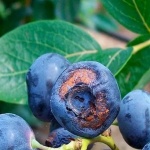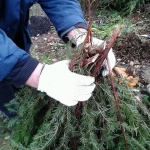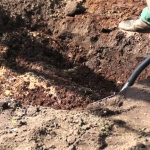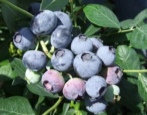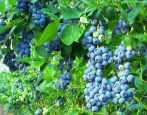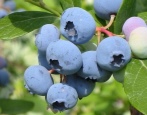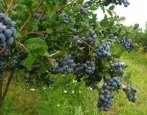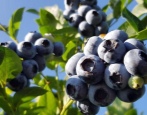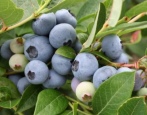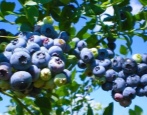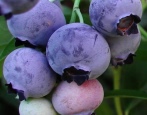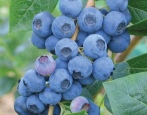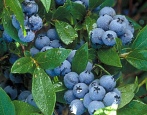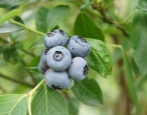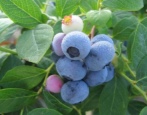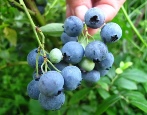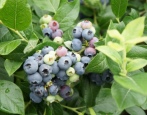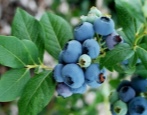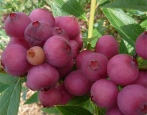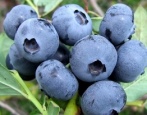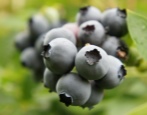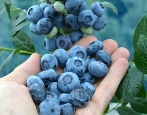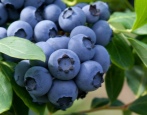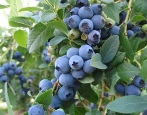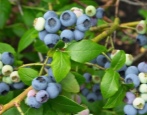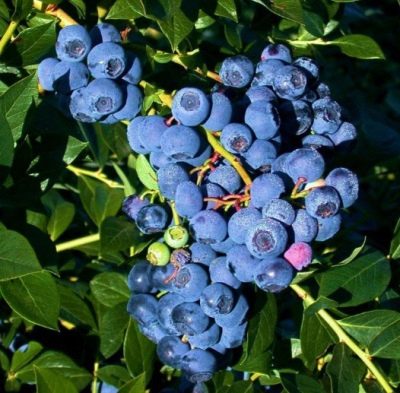
- Authors: New Zealand selection
- Ripening terms: early
- Growth type: tall
- Bush height, m: 1,7 – 2
- Taste: rich, sweet
- Yield: high
- Average yield: 8-10 kg per bush
- Fruit size: medium or large
- Fruit color: deep blue, slightly dark
- Description of the bush: straight, very energetic
Blueberries are considered one of the most favorite berries among Russians. It has become a leader and remains among them due to its unusual and pleasant taste, mouth-watering aroma and benefits. With regular use of blueberries, well-being is noticeably improved. Doctors recommend it to combat many ailments.
River blueberry is considered one of the most common varieties. It stands out favorably against the background of the rest due to its high resistance to frost and excellent taste.
Description of the variety
Formed tall shrubs consist of straight and spreading branches. When a large number of berries are formed, the branches are attached to trellises or other supports. The height ranges from 1.7 to 2 meters. The crown is massive and powerful.
You can determine the variety by the structure of the root system, which consists of two types of roots. Overgrowing roots are formed in the upper layers of the soil, and skeletal ones are directed deeper. The root system is developed enough to absorb water from deep soil layers.
The foliage is colored deep green. The shape is oval and oblong. The edges are not jagged and the texture is smooth. The front surface of the sheet is glossy, and the back side is matte.
The fast-growing variety Reka has excellent resistance and easily adapts to almost any climatic conditions. Resistance to low temperatures is very important when growing varieties within the borders of most regions of Russia.
During flowering, the decorative characteristics of the plant reach a peak. The branches are covered with a large number of white-pink flowers with a rich and pleasant aroma.
Fruit characteristics
Berries can be large or medium in size. It all depends on the climate in which blueberries grow, as well as weather conditions and care. The diameter ranges from 17 to 19 millimeters, and the weight ranges from 1.8 to 2 grams.
The color of the berries is deep blue, slightly dark. The pulp is firm, but very juicy. For a long time after the final ripening, the fruits remain hanging on the shoots. The crop can be harvested using mechanical means. Excellent transportability allows the berry to be grown commercially and transported over long distances without loss of quality.
It has long been known that fruits are rich in vitamins, fiber and antioxidants. All these components are needed by the human body to perform the inherent functions. If you eat a portion of fresh berries every day, a noticeable strengthening of the nervous system and immunity is observed, and the work of the intestines is getting better. And also the fruits will have a positive effect on blood vessels and the work of the cardiovascular system.
The fruits of the above variety can be stored for a long time without losing their appearance and taste. These characteristics also positively influenced the popularity and distribution of the Reka variety.
Taste qualities
If you are looking for a variety to consume naturally, Reka blueberries will do the trick because of their bright sweet taste. Most summer residents who have personally tasted the crop note its similarity to blueberries. The aroma of the berries is pleasant. The purpose of the berries is universal. Their taste is enjoyed in its natural form, and is also used to prepare various desserts.
Ripening and fruiting
This variety belongs to the early varieties, and the fruiting period begins in the second half of July.The first crop can be harvested only three years after the seedlings have taken root. In the first year, you should not count on a rich harvest, but every year this figure will increase markedly.
Yield
One of the main advantages of the Reka variety is its high yield. On average, one plant produces from 8 to 10 kilograms.
The yield of blueberries is influenced by many factors: the age of the shrubs, adherence to agricultural practices, the composition and texture of the soil, and the place of planting. It will be difficult to achieve high yields if the seedlings are planted in depleted soil or climatic conditions that are not suitable for growing fruit crops.
Growing and care
As soon as the planting process comes to an end, they begin to mulch the soil. Organics are best suited for this purpose, for example, pine needles, foliage, sawdust or hay. It is not only moisture preservation, but also plant nutrition. Organic matter gradually decomposes and penetrates into the soil.
Before and after watering, weeding should be performed so that moisture is absorbed into the soil faster, and the root system receives the required amount of oxygen. Do not deepen the garden tool too deeply while working. Remember that some of the roots are located in the upper layers of the soil and can be easily damaged.
Berry bushes are irrigated about twice a week, spending 2 buckets of settled water per plant. The irrigation scheme is adjusted taking into account the weather. In the rainy season, I reduce the regularity of watering, or completely refuse additional moisture. In the hot season, more water is consumed so that blueberries do not experience a lack of it.
In the spring, top dressing is introduced - 50 grams of sulfur powder. With its help, it is easy to maintain the desired acid balance. And also pruning is performed in the spring. It is important to have time to do it before bud break. Be sure to get rid of broken, dry and diseased branches. Excess growth is also removed. Experienced gardeners are advised to leave only 7 powerful branches.
As for the choice of land, blueberries grow and bear fruit on any soil.
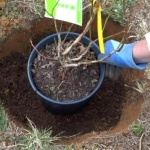
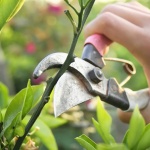
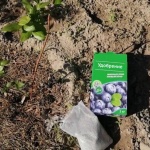
Disease and pest resistance
When growing any garden crop, it should be borne in mind that they can all suffer from dangerous pests and various diseases. Blueberry The river is often affected by fungal infections that become active during cold and rainy summers. Since the fungus loves high humidity, water stagnation in the area should not be allowed.
The root system often suffers from tracheomycotic wilting. Spores of the fungus remain in the ground and in plant debris, therefore, garbage on the territory is disposed of regularly.
As for pests, they also pose a danger to blueberries: triangular leafworm, peat jaundice, heather lancet and other insects.Even insects as harmless at first glance as butterflies sometimes damage bushes at the caterpillar stage.
Experienced gardeners confirm that the River variety rarely gets sick with regular and careful care, and after the damage the shrubs are able to recover on their own.
Each summer resident will confirm that preventing infection is much easier than treating it later. As a preventive measure, it is advisable to treat the shrubs with a Bordeaux mixture using a spray bottle. And also the shrubs are watered with "Fitosporin". It is necessary to periodically carefully examine the plants for the presence of caterpillar larvae. They are collected by hand.
If the disease is massive, treatment is carried out with the following compositions: "Iskra", "Fufanon", "Inta-Vir" and various analogues. Use drugs before flowering. It is important to take measures in time so that the disease does not spread to healthy plants.
